Birds from all over the world flock to shores, bays, and estuaries, but not for the same reasons people do. But some species can be found along coastlines more than others. These species depend on the sea for resting, nesting, and feeding. And where there is plenty of life, more life will flourish. So while relaxing in the sand with a drink in your hand, learn about 15 awesome and unique types of beach birds.
1. Seagull

You are most likely to find seagulls on the beach during summer.
©iStock.com/Evgenyi_Eg
Seagulls are large seabirds with long bills and webbed feet, closely related to terns and skimmers. They feature grey and white feathers with dark markings on their heads and wings. Seagulls are known for being noisy scavengers. This species has a cosmopolitan range, breeding on every continent, including Antarctica. They live along ocean coastlines, bays, and major lakes and nest in sea cliffs and sand dunes. You are most likely to find seagulls on the beach during summer and further inland in winter near farm fields and reservoirs.
2. Pelican
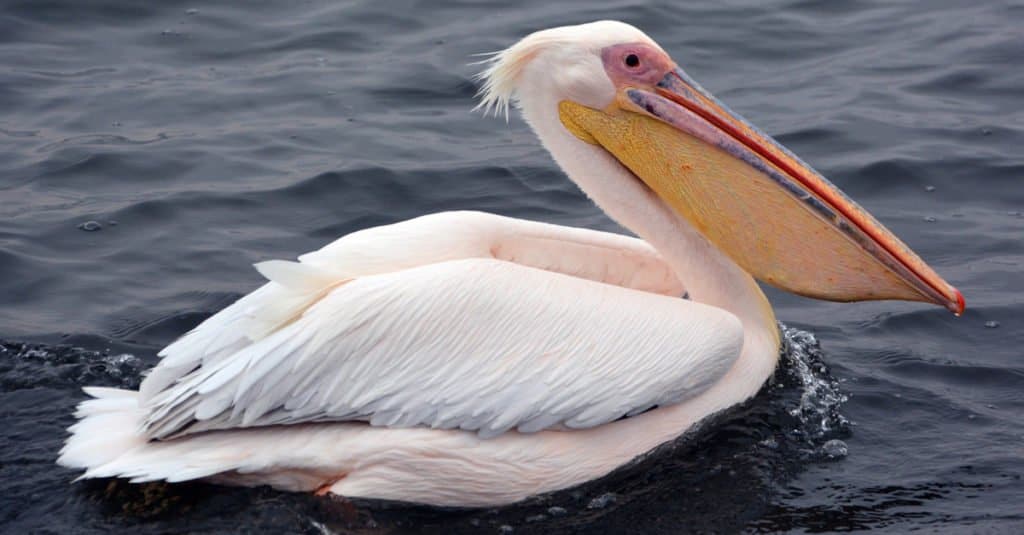
Pelicans are distinguished from other birds because all four of their toes are webbed!
©meunierd/Shutterstock.com
Pelicans are large aquatic birds with long beaks and throat patches. Most pelican species are white with yellow bills and some black or brown wing feathers. These birds also have a global distribution, although less than the seagull. They live in tropical and temperate zones near inland and coastal waters but are absent from the open ocean and polar regions. In America, you can find white pelicans breeding in inland Canada and wintering along the Gulf of Mexico.
3. Avocet
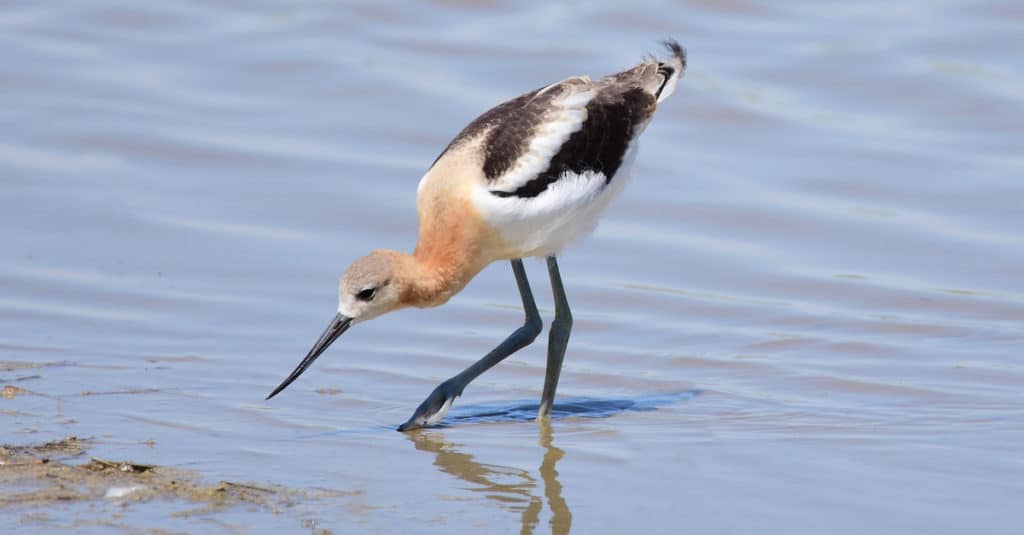
The American avocet winters along the North American coastlines near wetlands and salt ponds.
©Nina B/Shutterstock.com
Avocets are waders in the stilt family, and they feature long legs and long, thin, upcurved bills. These birds have pied plumage, meaning their bodies feature white plumage with black markings. Most stilts feature black bills and black markings on their wings. These species are found on several continents, including North America, South America, Europe, Asia, and Australia. You can often find them in estuaries, where they feed on mudflats and exposed bay mud—the American avocet winters along the North American coastlines near wetlands and salt ponds.
4. Tern

Terns nest on rocky islands, salt marshes, and beaches and forage over open water.
©iStock.com/YanLev
The tern is a seabird from the same family as gulls and skimmers. They are slender birds with forked tails, long bills, and thin wings. While there are several tern species, most are grey above and white below, with black caps and yellow bills. And unlike many birds, males and females are identical in appearance. Terns have a worldwide distribution, where they nest on rocky islands, salt marshes, and beaches and forage over open water. You can also find them in inland freshwater lakes.
5. Jacana
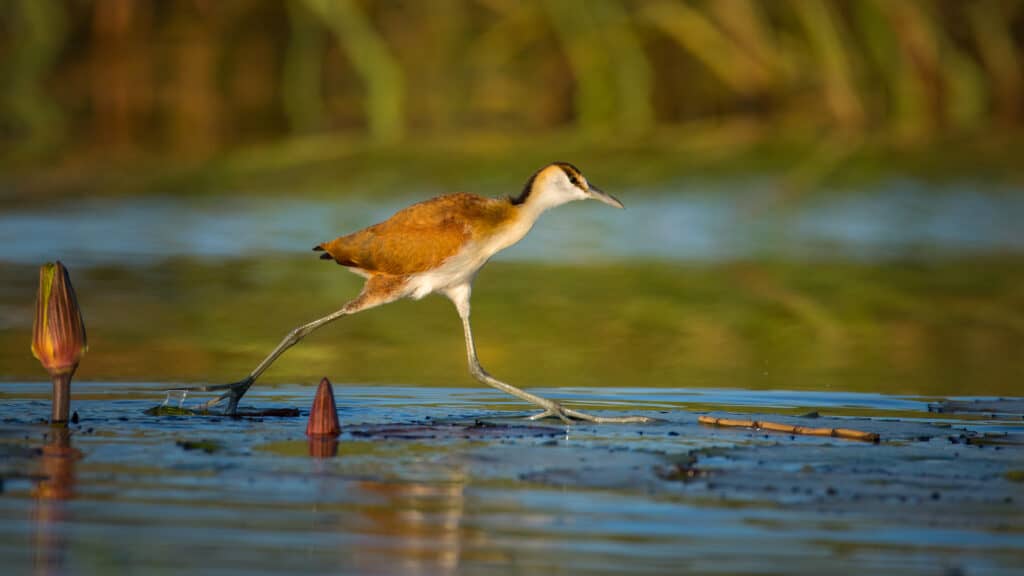
The lesser jacana is nomadic, often moving in search of temporary wetland habitats.
©JMx Images/Shutterstock.com
The jacana, or Jesus bird, is a tropical wading bird from tropical regions across the world. They get their nickname from their elongated feet and toes, which allow them to walk on floating aquatic vegetation. These birds are famous for their unique reproduction and parenting styles, where females are the dominant and males incubate and raise the young. There are eight living jacana species, most of which are found in Africa, Australia, Asia, and South America. They live anywhere there is an abundance of lily pads and other floating vegetation, such as marshes, lagoons, swamps, and lakes.
6. Sandpiper
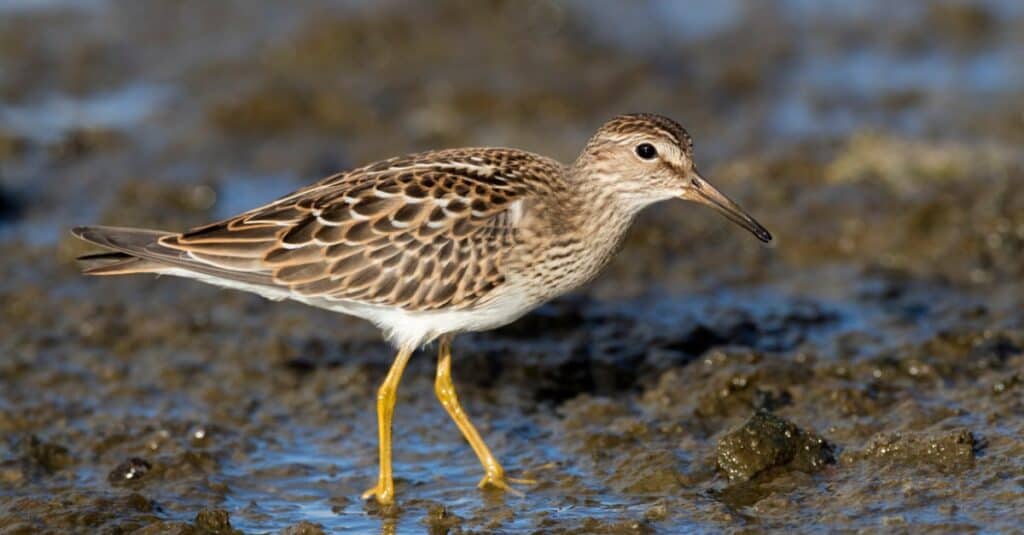
You can find sandpipers near seashores during winter.
©Agami Photo Agency/Shutterstock.com
Sandpipers are another wader species, and they feature long bodies, long legs, and narrow wings. These species are small to medium-sized birds with specialized beaks that allow them to feel the mud and sand as they look for food. Depending on the species, sandpipers feature a blend of brown, gray, white, and black plumage. They have an enormous range across most of the world except for Antarctica. During breeding, they inhabit inland lakes, ponds, and streamsides; you can find them near seashores during winter.
7. Oystercatcher

Oystercatchers prefer to inhabit intertidal areas and adjacent beaches.
©Paul Wranek – Copyright A-Z Animals
The oystercatchers are a group of large, noisy waders with long orange bills used for smashing mollusks. There are 12 oystercatcher species, but they show little variation in their appearance; they are either all-black or black on top and white underneath. You can find them on every continent except Antarctica, and they prefer to inhabit intertidal areas and adjacent beaches like barrier islands. This unique habitat keeps them secure from predators and offers an abundance of food.
8. Plover

You can find plovers on sandy beaches along coastlines.
©Rajh.Photography/Shutterstock.com
Plovers are medium-sized wading birds found worldwide, except in polar regions and arid deserts. Unlike most waders, they feature short bills and hunt by sight rather than by feel. There are over 60 plover species, most of which have white, black, grey, and brown plumage variations. Many are migratory birds and inhabit sandy beaches along coastlines. And some also live on inland lakeshores. The American golden plover is a long-distance migrant that passes through the United States, stopping to feed in lagoons and estuaries.
9. Stilt
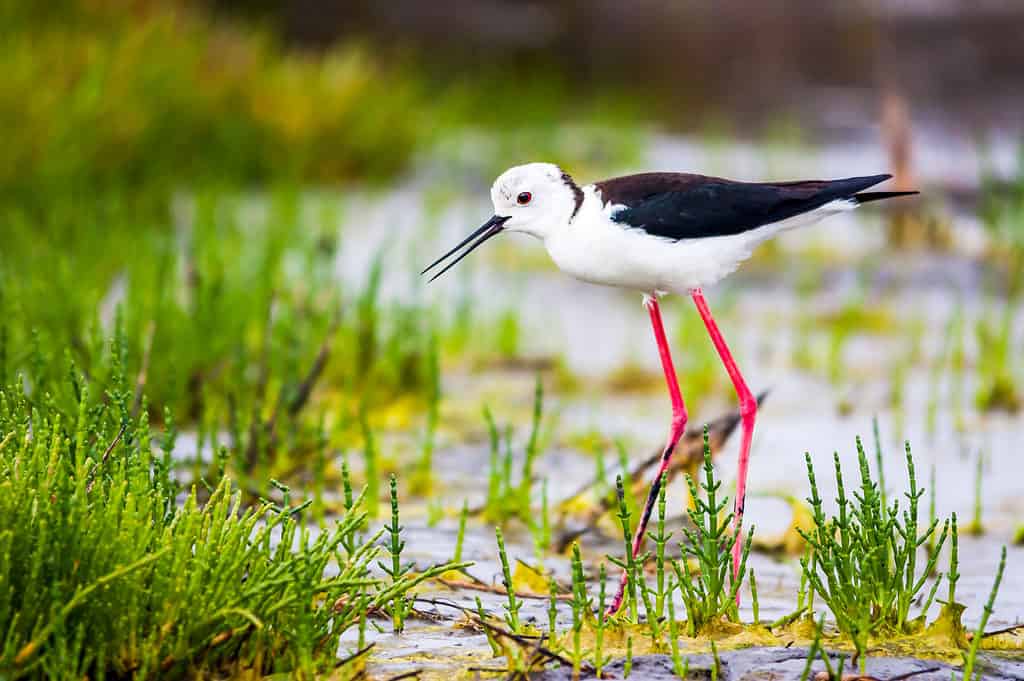
You can find stilts in salt ponds, flooded rivers, shallow lagoons, salt marshes, and mangrove swamps.
©Taniaaraujo/Shutterstock.com
The stilts are a group of shorebirds featuring extremely long legs and long, skinny bills. These birds inhabit warm and hot climates on every continent except for Antarctica, where they reside in brackish wetlands. There are five stilt species, most of which have pied plumage (white with black markings), black bills, and pink legs. The black-necked stilt is native to the Americas and lives year-round in South America, Central America, the Caribbean, Mexico, and California. It also breeds along the Atlantic Coast and the Gulf of Mexico. You can find them in salt ponds, flooded rivers, shallow lagoons, salt marshes, and mangrove swamps.
10. Albatross

Albatross have various shades of plumage, ranging from white, brown, gray, and black.
©Agami Photo Agency/Shutterstock.com
The albatross is a large seabird wide-ranging across the Southern and North Pacific Oceans. It is one of the largest flying birds on earth and feature the longest wingspan of any living bird, reaching 12 feet long. There are 22 albatross species, and most are listed as threatened, vulnerable, or critically endangered. Feather harvesting is the primary reason for their steep decline. Albatross have various shades of plumage, ranging from white, brown, gray, and black. But they all possess long, narrow wings and strongly hooked bills.
11. Heron

The grey heron’s yellow bill turns more orange during the breeding season.
©Angyalosi Beata/Shutterstock.com
Herons are freshwater and coastal birds with 72 recognized species. They feature long legs, long necks, and long bills, and each species comes in various colors, such as brown, black, white, and grey. These birds are widespread with global distribution; most are associated with water, although they don’t swim. You will mainly find them in lowland areas, where they feed on the water’s edge at lakes, ponds, rivers, swamps, and the sea.
12. Flamingo

You can often find flamingoes foraging in big, noisy groups.
©Ondrej Prosicky/Shutterstock.com
Flamingoes are large, bright pink-wading birds in the Americas and Afro-Eurasia. The greater flamingo is the largest in the species, weighing over seven pounds and reaching 4.7 feet high. They get their pink color from the food they consume, and you can often find them foraging in big, noisy groups. They live in a variety of habitats, but the most common include mangrove swamps, tidal flats, lagoons, and sandy islands.
13. Ibis
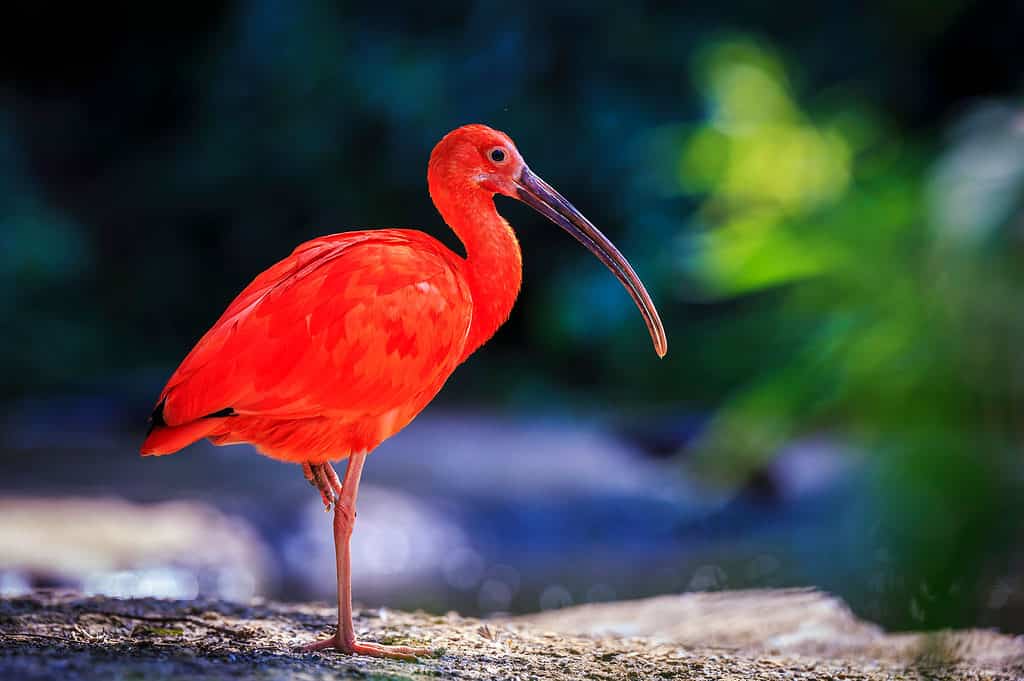
You can find ibis inhabiting coastal marshes and wetlands.
©SanderMeertinsPhotography/Shutterstock.com
Ibises are long-legged wading birds featuring long, downward-curved bills. There are 29 living ibis species, many of which live in Asia, Africa, and South America. The white ibis is native to North and South America, inhabiting coastal marshes and wetlands and feeding in brackish or saltwater environments. Ibises come in different color forms, ranging from white, grey, black, red, green, brown, and orange.
14. Skimmer
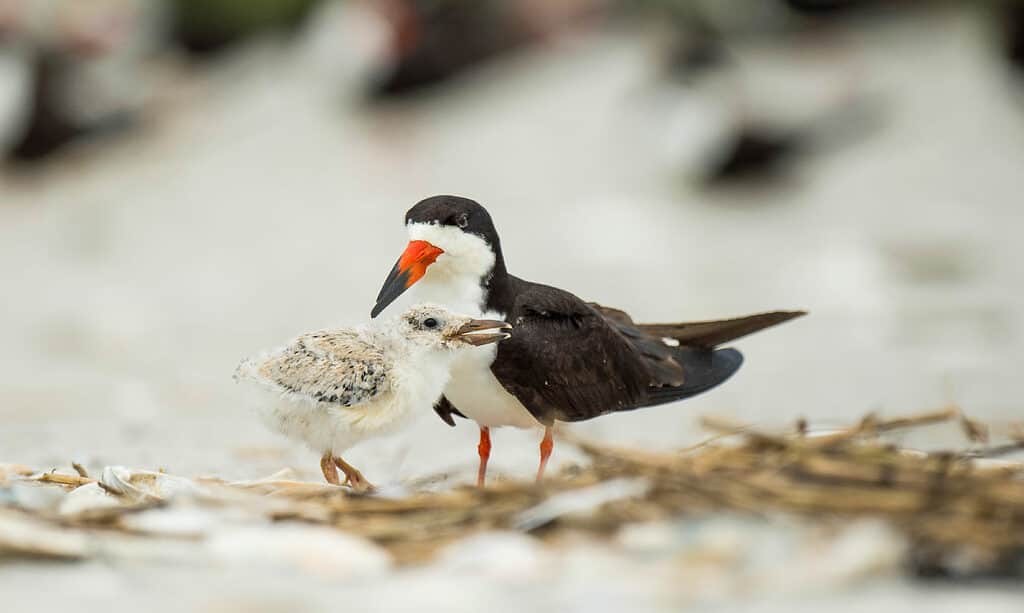
The black skimmer spends its life in coastal areas around sandy beaches and islands.
©Ray Hennessy/Shutterstock.com
Skimmers are similar to terns and reside in the seabird family. There are only three species in their genus, and they live in South Asia, Africa, and the Americas. They feature uneven bills that allow them to easily skim fish from the water’s surface as they fly low over rivers and oceans. Each species looks similar, featuring black or brown above, white below, and red and orange bills. The black skimmer found in North and South America spends its life in coastal areas around sandy beaches and islands.
15. Cormorant
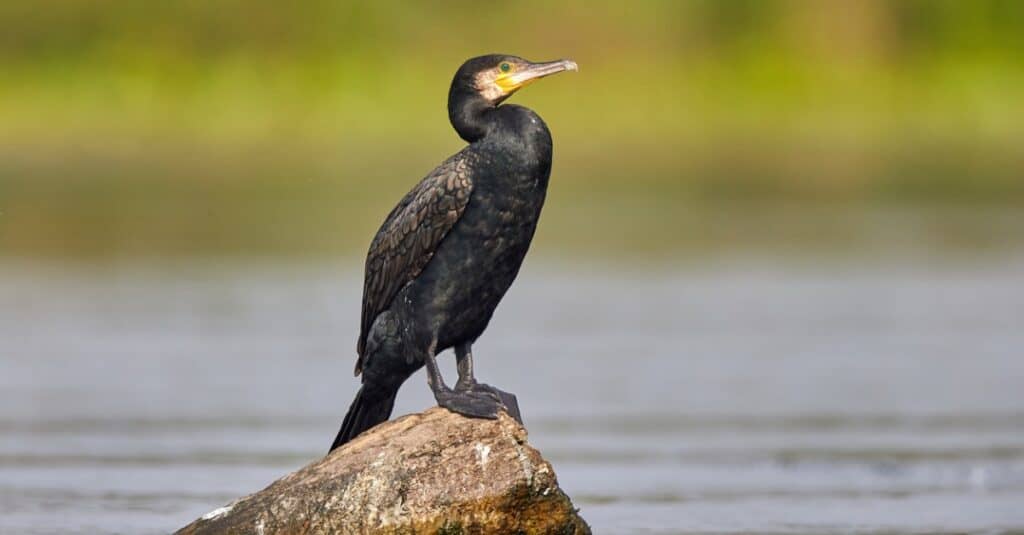
The cormorant can live in most aquatic habitats.
©iStock.com/Richard Constantinoff
Cormorants comprise 40 species of aquatic birds and are another group of awesome types of beach birds. They are medium to large birds with long, thin, hooked bills, webbed feet, and long wings. Most species feature black and white plumage, with colored skin on their face. But some cormorants also have colorful plumage, like the spotted shag in New Zealand. They can live in most aquatic habitats, including rocky coasts, mangrove swamps, bays, lakes, and rivers.
Up Next:
The photo featured at the top of this post is © Volodymyr TVERDOKHLIB/Shutterstock.com
Thank you for reading! Have some feedback for us? Contact the AZ Animals editorial team.







